Antibody data
- Antibody Data
- Antigen structure
- References [1]
- Comments [0]
- Validations
- Western blot [2]
- Immunocytochemistry [3]
- Immunohistochemistry [8]
- Other assay [1]
Submit
Validation data
Reference
Comment
Report error
- Product number
- PA5-56181 - Provider product page

- Provider
- Invitrogen Antibodies
- Product name
- Septin-7 Polyclonal Antibody
- Antibody type
- Polyclonal
- Antigen
- Recombinant protein fragment
- Description
- Immunogen sequence: VNIIPLIAKA DTLTPEECQQ FKKQIMKEIQ EHKIKIYEFP ETDDEEENKL VKKIKDRLPL AVVGSNTIIE VNGKRVRGRQ YPW Highest antigen sequence identity to the following orthologs: Mouse - 100%, Rat - 100%.
- Reactivity
- Human, Mouse, Rat
- Host
- Rabbit
- Isotype
- IgG
- Vial size
- 100 μL
- Concentration
- 0.1 mg/mL
- Storage
- Store at 4°C short term. For long term storage, store at -20°C, avoiding freeze/thaw cycles.
Submitted references Proteomic analysis of the effect of the polyphenol pentagalloyl glucose on proteins involved in neurodegenerative diseases in activated BV‑2 microglial cells.
Mendonca P, Taka E, Soliman KFA
Molecular medicine reports 2019 Aug;20(2):1736-1746
Molecular medicine reports 2019 Aug;20(2):1736-1746
No comments: Submit comment
Supportive validation
- Submitted by
- Invitrogen Antibodies (provider)
- Main image
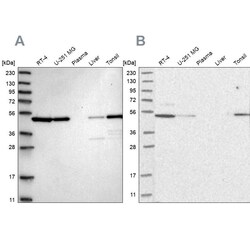
- Experimental details
- Western blot analysis of Septin-7 using Septin-7 Polyclonal Antibody (Product # PA5-56181) (A) shows similar pattern to an independent Septin-7 Polyclonal Antibody (B).
- Submitted by
- Invitrogen Antibodies (provider)
- Main image

- Experimental details
- Western blot analysis of Septin-7 in human cell line U-2 OS using a Septin-7 Polyclonal Antibody (Product # PA5-56181).
Supportive validation
- Submitted by
- Invitrogen Antibodies (provider)
- Main image
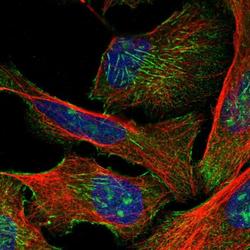
- Experimental details
- Immunofluorescent staining of Septin-7 in human cell line U-2 OS shows positivity in nucleoli, plasma membrane & actin filaments. Samples were probed using a Septin-7 Polyclonal Antibody (Product # PA5-56181).
- Submitted by
- Invitrogen Antibodies (provider)
- Main image
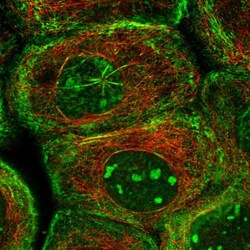
- Experimental details
- Immunofluorescent staining of Septin-7 in human cell line A-431 using Septin-7 Polyclonal Antibody (Product # PA5-56181) shows localization to nucleoli, plasma membrane & actin filaments.
- Submitted by
- Invitrogen Antibodies (provider)
- Main image
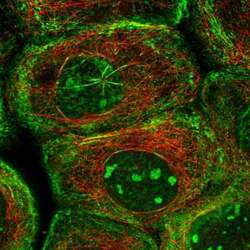
- Experimental details
- Immunofluorescent staining of Septin-7 in human cell line A-431 using Septin-7 Polyclonal Antibody (Product # PA5-56181) shows localization to nucleoli, plasma membrane & actin filaments.
Supportive validation
- Submitted by
- Invitrogen Antibodies (provider)
- Main image
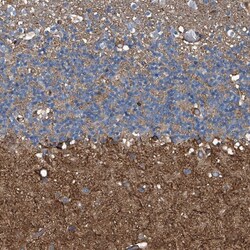
- Experimental details
- Immunohistochemical staining of Septin-7 in human cerebellum using a Septin-7 Polyclonal Antibody (Product # PA5-56181) shows moderate cytoplasmic positivity in Purkinje cells.
- Submitted by
- Invitrogen Antibodies (provider)
- Main image
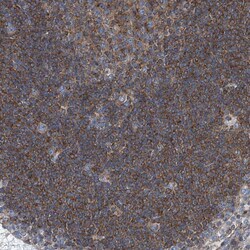
- Experimental details
- Immunohistochemical staining of Septin-7 in human lymph node using Septin-7 Polyclonal Antibody (Product # PA5-56181) shows moderate cytoplasmic positivity in non-germinal center cells.
- Submitted by
- Invitrogen Antibodies (provider)
- Main image
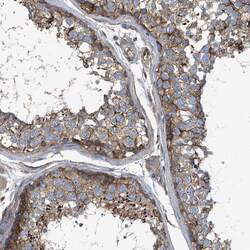
- Experimental details
- Immunohistochemical staining of Septin-7 in human testis using Septin-7 Polyclonal Antibody (Product # PA5-56181) shows moderate positivity in cells in seminiferous ducts.
- Submitted by
- Invitrogen Antibodies (provider)
- Main image
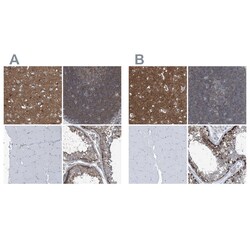
- Experimental details
- Immunohistochemical staining of Septin-7 in human cerebral cortex, lymph node, skeletal muscle and testis using Septin-7 Polyclonal Antibody (Product # PA5-56181) (A) shows similar protein distribution across tissues to an independent Septin-7 Polyclonal Antibody (B).
- Submitted by
- Invitrogen Antibodies (provider)
- Main image
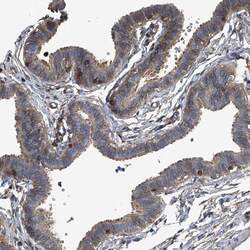
- Experimental details
- Immunohistochemical staining of Septin-7 in human fallopian tube using Septin-7 Polyclonal Antibody (Product # PA5-56181) shows strong cytoplasmic positivity in glandular cells.
- Submitted by
- Invitrogen Antibodies (provider)
- Main image
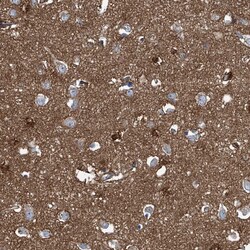
- Experimental details
- Immunohistochemical staining of Septin-7 in human cerebral cortex using Septin-7 Polyclonal Antibody (Product # PA5-56181) shows strong cytoplasmic positivity in neuropil.
- Submitted by
- Invitrogen Antibodies (provider)
- Main image
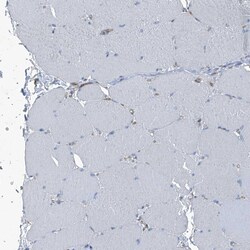
- Experimental details
- Immunohistochemical staining of Septin-7 in human skeletal muscle using Septin-7 Polyclonal Antibody (Product # PA5-56181) shows no positivity in myocytes as expected.
- Submitted by
- Invitrogen Antibodies (provider)
- Main image
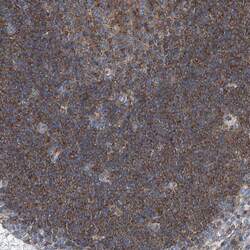
- Experimental details
- Immunohistochemical staining of Septin-7 in human lymph node using Septin-7 Polyclonal Antibody (Product # PA5-56181) shows moderate cytoplasmic positivity in non-germinal center cells.
Supportive validation
- Submitted by
- Invitrogen Antibodies (provider)
- Main image
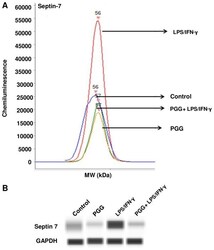
- Experimental details
- Figure 3. Effect of PGG on the expression of septin-7 as determined by western analysis with automated capillary electrophoresis. (A) Graph of the amount of chemiluminescence measured in the different treatments. (B) Bands representing the protein expression in control (DMSO), PGG (25 uM), LPS/IFNgamma, and pretreated cells (PGG + LPS/IFNgamma) after 24 h of treatment (n=3). PPG, polyphenol pentagalloyl glucose (1,2,3,4,6-penta-O-galloyl-beta-D-glucose); LPS, lipopolysaccharide; IFNgamma, interferon gamma.
 Explore
Explore Validate
Validate Learn
Learn Western blot
Western blot